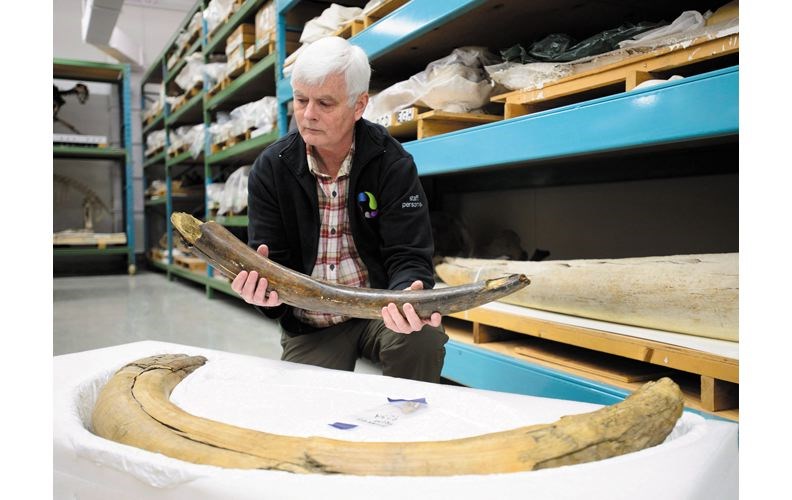For the past two weeks, we have been time travelling. Equated one year with one centimeter, we’ve taken a 45,400 kilometre long trip through the Earth’s history.
In contrast to geologic time, our lifespans are fleeting moments – a blink of the eye. Living to 100 years old would only represent one metre in our long trip through time.
This is not intended to make anyone feel insignificant. Quite the contrary because it is remarkable what humanity has accomplished in our short time on this planet. It is also depressing to consider the impact we have had.
The current or most recent Ice Age has lasted for the past 2.58 million years or the last 2.58 kilometres of our trip. Sitting at UNBC writing this, that distance would get me to the bottom of University way. It is a very short component of the history of our planet.
Modern humans – homo sapiens - evolved during this time. Our earliest known hominid ancestor, an Australopithecus afarensis named “Lucy”, lived 3.2 million years ago. All of the sub-species of humans have emerged since then. Homo sapiens are only the latest hominid. We evolved approximately 200,000 years ago in east Africa or a mere 200 metres from our journey’s end.
We have been a very successful species as we have spread across the entire world. We survived the last ice age which began around 110,000 years ago and only receded 12,000 years in the past. We have come to dominate all of the environments in which we live.
In the last 200 metres of our journey through time, there was only one other significant interglacial period such as we are experiencing now. The rest of the time, glaciers have ruled the planet. In many ways, we are children of snow and ice but we have survived.
Current thinking suggest there were multiple waves of human migration starting with the Middle East and spreading from there. Some evidence suggests modern humans first left Africa as early as 190,000 years ago.
Wherever we have traveled, humans have had a significant impact on the megafauna in the new lands. We are a successful species but destructive.
In the past few thousands of years, the world has lost over half of its land mammals. Perhaps more importantly, many species which still exist have been pushed from populations numbering in the millions to a few thousand or fewer.
Compared to the other mass extinctions of life on this planet, the loss of species diversity has happened incredibly fast – comparable to the extinction of the large dinosaurs and we know the cause for that.
What does it say that wooly mammoths, European lions, Volkswagon-sized ground sloths, carnivorous kangaroos, and the North American camel all survived the mercurial swings in climate between glacial and interglacial periods for millions of years but have disappeared in the last 20 metres of our trip?
A wave of extinctions has mirrored the migrations of this recently evolved African species Homo sapiens as it has broadened its habitat range. Starting a few tens of thousands of years ago, large-scale extinctions jumped from continent to continent and eventually to remote islands. It continues to this day.
While these extinctions cannot be causally linked to human migration, Australia lost its marsupial lion and its giant kangaroos between 40,000 and 50,000 years ago as the continent was being populated by the ancestors of modern aboriginal Australians. It also lost diprotodons – giant lumbering herbivorous marsupials – along with 6 foot tall flightless birds, two species of terrestrial crocodiles, a giant python, and a 15 foot lizard called megalania. Indeed, it lost every land animal species weighing more than 100 kilograms.
In Europe and Asia, local fauna have experienced a more prolonged extinction which claimed the wooly and not-so-wooly rhinoceroses, giant deer with 12 foot antlers, cave bears and cave lions, and spotted hyenas. Perhaps more devastating was the loss of the Neanderthal species of hominids which did not survive the arrival of Homo sapiens.
About 15,000 years ago, humans spread to North America. Subsequently, the continent lost four species of mammoths, the elephant-like gomphotheres, giant ground sloths, armadillos weighing more than a ton, beavers the size of bears and bears larger than any species alive now. Giant peccaries, tapirs, stag moose, giant capybaras, wild dogs, dwarf antelopes, brush oxen, woodland mush oxen, and mastodons all disappear from the fossil record at about the same time as humans moved in.
Is the human race the cause? Not necessarily as North America was coming out of a glacial period and shifting climate may have had an impact. But the record from tree pollen and spores would suggest otherwise.
Our most recent bout of climate change is not the only threat to life on this planet. In geological terms, we are living in a mass extinction but without the perspective of time, it is hard to see.



